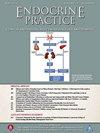美国临床内分泌学会共识声明:成人血脂异常管理算法- 2025年更新。
IF 4.6
3区 医学
Q2 ENDOCRINOLOGY & METABOLISM
引用次数: 0
摘要
目的:提供简明算法和表格的视觉指导,以协助临床决策管理成人血脂异常,以降低ASCVD和甘油三酯诱发的胰腺炎的风险。方法:召集一个国际多学科临床专家工作组,更新2020年针对血脂异常的AACE算法。文献检索为视觉指导图形和反映工作组共识的支持性叙述的创建提供了信息。结果:成人血脂异常管理2025算法包括以下几个部分:(1)以患者为中心的血脂异常管理指导原则;(2)血脂异常的风险评估和检测;(3)识别遗传性血脂异常;(4)针对成人血脂异常患者的具体生活方式建议;(5)针对低密度脂蛋白胆固醇进行药物治疗预防成人ASCVD;(6)成人他汀类药物相关肌肉症状的治疗方法;(7)成人高甘油三酯血症的治疗;(8)特殊血脂异常人群的管理(老年人、接受变性治疗或艾滋病毒控制的成年人、自身免疫性疾病的成年人、儿童癌症幸存者、器官移植的成年人);(9)孕妇和哺乳期患者高胆固醇血症的管理;(10)孕妇和哺乳期患者高甘油三酯血症的管理;(11) fda批准的治疗血脂异常的药物。结论:2025年血脂异常算法更新与2025年AACE成人血脂异常药理学管理临床实践指南和其他最近的AACE指南一致。该算法也符合该工作队所代表的其他国际机构提供的指导。该更新强调ASCVD风险评估,解决胰腺炎风险,并强调个体化药物治疗。该算法考虑了健康公平、成本效益以及不同管理方案的利弊。本文章由计算机程序翻译,如有差异,请以英文原文为准。
American Association of Clinical Endocrinology Consensus Statement: Algorithm for Management of Adults with Dyslipidemia – 2025 Update
Objective
To provide visual guidance in concise algorithms and tables to assist with clinical decision making in the management of adults with dyslipidemia to reduce risk of ASCVD and triglyceride-induced pancreatitis.
Methods
An international multidisciplinary task force of clinical experts was convened to update the 2020 AACE algorithm for dyslipidemia. Literature searches informed the creation of visual guidance graphics and supporting narratives that reflect consensus of the task force.
Results
The 2025 algorithm for the management of adults with dyslipidemia includes the following sections: (1) guiding principles for patient-centered management of dyslipidemia; (2) risk assessment and testing for dyslipidemia; (3) identifying genetic dyslipidemias; (4) specific lifestyle recommendations for adults with dyslipidemia; (5) targeting LDL-cholesterol with pharmacologic therapy for ASCVD prevention in adults; (6) approach to statin-associated muscle symptoms in adults; (7) management of adults with hypertriglyceridemia; (8) management of special populations with dyslipidemia (older adults, adults receiving transgender care or HIV control, adults with autoimmune disorders, survivors of childhood cancers, adults with organ transplantation); (9) management of hypercholesterolemia in pregnant and lactating individuals; (10) management of hypertriglyceridemia in pregnant and lactating individuals; and (11) FDA-approved medications for dyslipidemia.
Conclusions
This 2025 dyslipidemia algorithm update aligns with the 2025 AACE Clinical Practice Guideline for Pharmacologic Management of Adults with Dyslipidemia and other recent AACE guidance. The algorithm is also in agreement with guidance provided by the other international bodies represented within this task force. This update emphasizes ASCVD risk assessment, addresses pancreatitis risk, and highlights individualized pharmacotherapy. The algorithm includes considerations on health equity, cost effectiveness, and the benefits and harms of different management options.
求助全文
通过发布文献求助,成功后即可免费获取论文全文。
去求助
来源期刊

Endocrine Practice
ENDOCRINOLOGY & METABOLISM-
CiteScore
7.60
自引率
2.40%
发文量
546
审稿时长
41 days
期刊介绍:
Endocrine Practice (ISSN: 1530-891X), a peer-reviewed journal published twelve times a year, is the official journal of the American Association of Clinical Endocrinologists (AACE). The primary mission of Endocrine Practice is to enhance the health care of patients with endocrine diseases through continuing education of practicing endocrinologists.
 求助内容:
求助内容: 应助结果提醒方式:
应助结果提醒方式:


